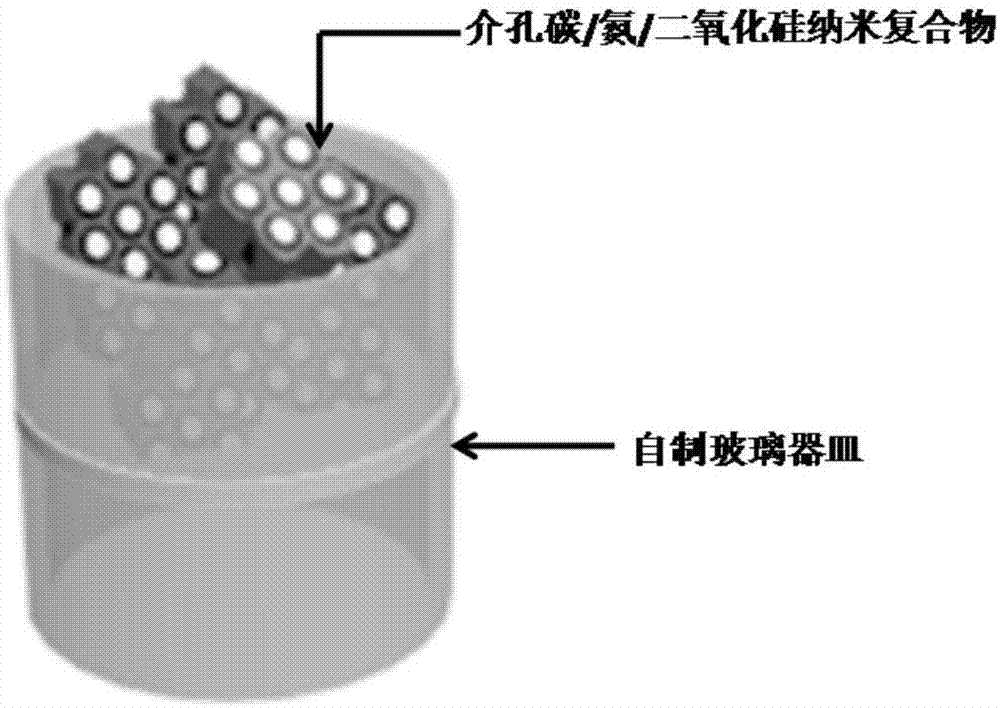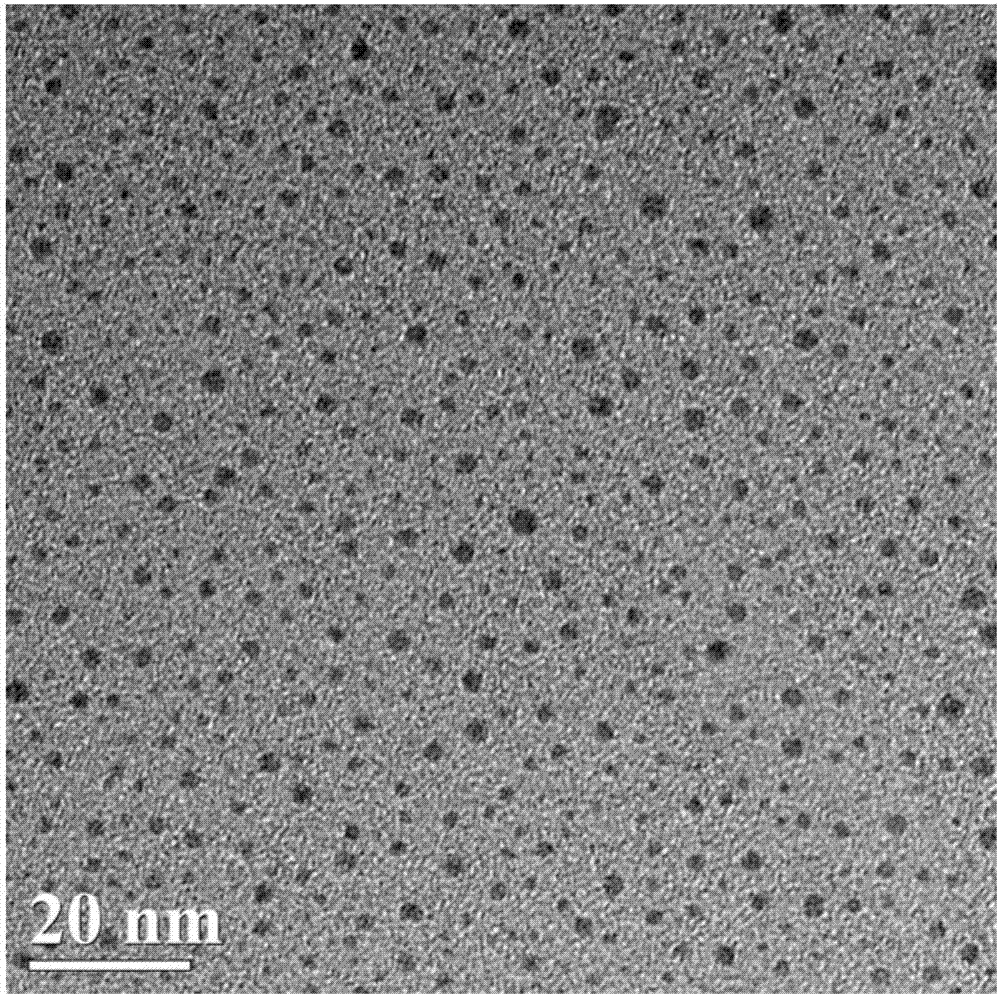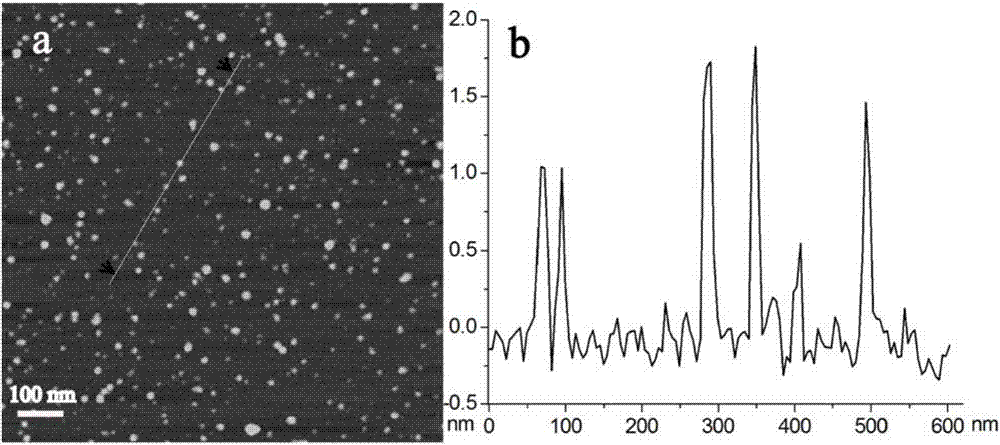Preparation method of nitrogen-doped graphene quantum dots (N-GQDs) and detection method of ascorbic acid
A technology of graphene quantum dots and ascorbic acid, applied in the field of fluorescence detection, achieves the effects of good dispersibility, uniform particle size, and solving difficulty in separation
- Summary
- Abstract
- Description
- Claims
- Application Information
AI Technical Summary
Problems solved by technology
Method used
Image
Examples
Embodiment 1
[0040] Example 1 Ordered mesoporous nitrogen-containing polymer / SiO 2 Preparation of composite materials
[0041] Mix ethyl orthosilicate, triblock copolymer P123 (Mw=5800), water and concentrated hydrochloric acid. This solution was transferred to an autoclave and reacted at 110°C for 24 hours. After the reaction, it was washed with a large amount of ultrapure water and ethanol and filtered, and the resulting product was dried at 60°C. Finally, the dried product was annealed at 550°C for 6 hours under air conditions to obtain ordered mesoporous silica SBA-15.
[0042] A mixture solution of pyrrole, trimethylbenzene, sulfuric acid and ethanol with a molar ratio of 1:5:3:0.4 was injected into SBA-15, heated in an oven at 80°C for 6 hours, and then reacted in an oven at 160°C for 8 hours. Then the obtained sample was heated at 800° C. in a nitrogen atmosphere for 4 hours to obtain a carbon / nitrogen / silica nanocomposite.
Embodiment 2
[0043] Example 2 Preparation of nitrogen-doped graphene quantum dots
[0044] Put the prepared carbon / nitrogen / silica nanocomposite in Example 1 into figure 1 In the glassware shown, put it in a reaction kettle containing concentrated nitric acid, and put the reaction kettle in an oven at 120-160°C for 1 to 3 hours. Finally, the glassware after the reaction was filtered in situ, and the yellow filtrate was collected as the N-GQDs solution.
[0045] Test the N-GQDs solution, see the results figure 2 , image 3 with Figure 4 , figure 2 This is a transmission electron micrograph of the N-GQDs prepared in Example 2 of the present invention; image 3 Are the atomic force microscope images and height images of the N-GQDs prepared in Example 2 of the present invention; Figure 4 This is the XPS spectrum of the N-GQDs prepared in Example 2 of the present invention.
[0046] by figure 2 It can be seen that the N-GQDs have uniform particle size and narrow distribution, with diameters rangi...
Embodiment 3A
[0049] Example 3 AA detection
[0050] Dilute 0.15~0.3mL of the N-GQDs solution prepared in Example 2 with 1.6~2mL of ultrapure water (≥18.2MΩ), then excite the N-GQDs with excitation wavelengths at 20nm intervals, with a slit of 5~10nm for fluorescence testing . The experimental results show that when the excitation wavelength is 340nm, its fluorescence emission peak intensity is the largest. Therefore, we choose 340nm as the excitation wavelength for the following fluorescence experiments.
[0051] The N-GQDs filtrate prepared in Example 2 was diluted with ultrapure water (≥18.2MΩ) to obtain a detection solution. Then add 50μM Fe 3+ Solution to form Fe 3+ -N-GQDs detection platform, and then add AA to measure the fluorescence intensity under different AA concentrations, and the recovered fluorescence intensity ratio F / F 0 It has a linear relationship with the amount of AA added, and draws a standard curve.
[0052] See results Figure 5 with Image 6 , Figure 5 This is Example ...
PUM
| Property | Measurement | Unit |
|---|---|---|
| Diameter | aaaaa | aaaaa |
| The average particle size | aaaaa | aaaaa |
Abstract
Description
Claims
Application Information
 Login to view more
Login to view more - R&D Engineer
- R&D Manager
- IP Professional
- Industry Leading Data Capabilities
- Powerful AI technology
- Patent DNA Extraction
Browse by: Latest US Patents, China's latest patents, Technical Efficacy Thesaurus, Application Domain, Technology Topic.
© 2024 PatSnap. All rights reserved.Legal|Privacy policy|Modern Slavery Act Transparency Statement|Sitemap



